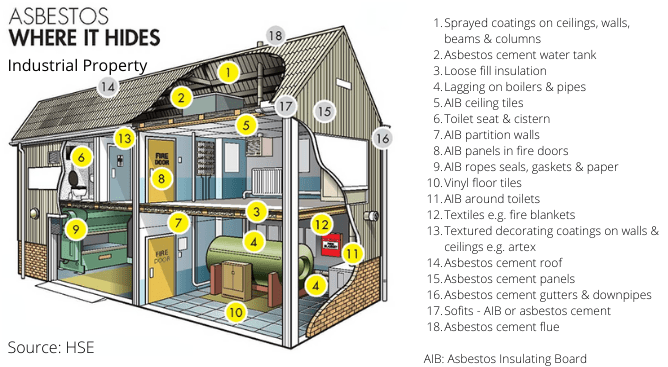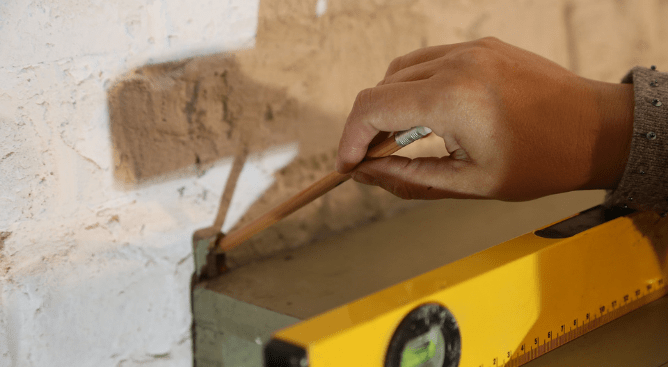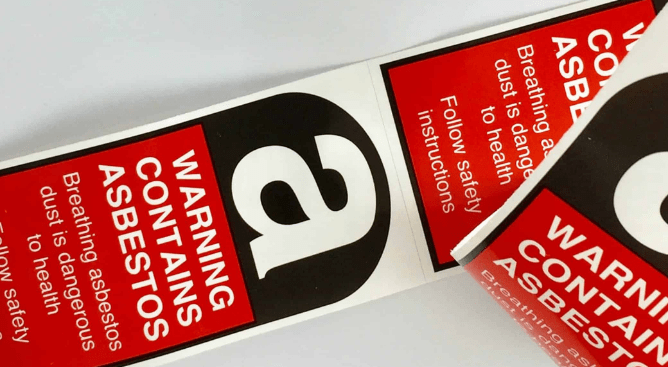Updated 21 July 2022.
Following our previous posts: 'Why do I need an asbestos register?' and 'When asbestos management goes wrong', it seemed pragmatic to explain the different levels of asbestos-related training and explain under what circumstances each level is appropriate.
As specialists in asbestos management, based in Kent, we also strive to education and inform and in this post we want to differentiate between the different levels of training - from basic awareness training to licensed Asbestos removal training.
Within the flow of the Duty to Manage Asbestos, there are different levels of training, but most seem to focus on the workers and supervisors that are actually at risk of coming into contact with Asbestos Containing Materials (ACMs) during their work.
There are 3 main levels of information, instruction and training. These relate to:
- Asbestos awareness.
- Non-licensable work with asbestos including Notifiable Non License Work (NNLW).
- Licensable work with asbestos.
If you have any questions relating to Asbestos and its management, contact us.
Asbestos awareness training
Here at Asbestos Limited, we have frequently referred to this type of training as half a day of being told:
“You don’t know enough about this, so find someone who does.”
This level of training does not prepare you to carry out work with ACMs, it simply ensures that you would be more aware if something of concern is revealed during your work, you’d know to stop and get it checked out, before creating an exposure.
Non-licensable work with asbestos including Notifiable Non License Work (NNLW)
This type of training is hands-on and covers working with low-risk ACMs. It also requires a full Risk Assessment to inform a Plan of Work and where applicable, details and results of any relevant air monitoring.
The Health & Safety Executive (HSE) has a fantastic resource in the Asbestos Essentials section, where you can find relevant task sheets to ensure that the work is carried out in conjunction with the Approved Codes of Practice.
However, in our opinion, we don’t agree with all of the content listed under the section for Strictly controlled minor work on Asbestos Insulation Board (AIB). Whilst we can accept A3, A5 and at a push, A7, undertaking the work as listed in the other task sheets has too much potential to go wrong. Repercussions of mistakes with AIB are far more hazardous than the other products mentioned.
To demonstrate our point:
For example, make a mistake with an Asbestos Cement (AC) sheet and accidentally break it and the sheet will usually break with relatively clean edges. AIB, on the other hand, would tear and the fibre release would far outweigh the fibre release from AC and the other products covered in Asbestos Essentials. Our advice would be to think long and hard before approaching this type of work.
Licensable work with asbestos
Now this is for the high risk, really scary stuff and usually has a 14 day notification period to the HSE by the licensed contractors. It involves work within full enclosures, with negative pressure units, air testing etc. and usually looks like something out of the film set from E.T.!
Only competent workers and managers, provided with suitable information instruction and training and using appropriate respiratory and other protective equipment, may undertake licensed asbestos work.
How do you establish whether the work is licensable or non-licensable work with asbestos?
Well in a perfect world, which we know it isn’t, the Asbestos Management Plan would inform this. The difficulty is that most sites don’t have a suitable and simple system in place for their appointed person(s) to keep updated.
We believe the process is actually pretty simple and where our phrase comes from:
“Asbestos is complex, but with our help, it doesn't have to be complicated.”
Essentially you just need to establish what the risk is, decide what action you are going to take, document the proof that you took it and update your management plan to record what happened.
Training comes in many forms. There is classroom based training, on the job training and the training you get from your own research and interactions with different people. What you don’t want to have is training from "The bloke down the pub said”, or “Nah mate, there’s no asbestos here”.
A few years back, we had a site operative contact us to ask if we could test materials from a site he had been working on. He was cutting into walls to install air vents on a housing estate. He’d asked the site manager if it was OK to proceed and was told yes, just crack on. When the site operative returned to the site he found ‘a’ labels (asbestos warning labels) on the wall he had been working on.
Sadly, the sample returned a positive result and he will worry for the rest of his life about whether he will get ill (please refer to the HSE's page on asbestos-related and dangerous diseases). Never again will he start work without insisting on seeing a copy of the Asbestos Pre-Refurbishment/Demolition survey that relates to the area he is working in.
The correct (and safe) process to adopt would have been to carry out the RD survey at the planning stage of the work and thus inform the risk assessment. Once the risk had been established, the plan could have included for the vents to be installed on a different, non-asbestos containing wall. If this was not possible and the ACM was likely to be disturbed during the work, it could have been removed prior to installation of the vents.
Timeframes for asbestos surveys
You have to bear in mind that if the survey is not carried out at least 4 weeks prior to work being required, there is no time to resolve the issue properly and cost effectively.
Using the air vent scenario - if the wall had returned a positive result on the 1st of February, it could then take 2 weeks to write a spec., get quotes in from Licensed Asbestos Removal Contractors (LARCs) and appoint one. Once appointed, the LARC then needs to create a plan of works, prior to notifying the HSE within the required 14 day’s notice. This could easily take you past the minimum 4 weeks allowed and work can’t start till March at the earliest.
There is always the excuse that there isn’t enough time, but back to that perfect world. There is always at least one person who decides on any future plans for a pre-2000 building and if they ensure that the Duty Holder is involved, they can make sure this is planned into the timeline:
- Work is required to the building: finances, resources and time impact are assessed.
- It is decided that the work can proceed.
- Carry out a review of the Risk Assessments (RAs) required for the work, i.e. Asbestos/Electric/Fire etc.
- Get quotes in for the required RAs, review and appoint.
- Plan the RAs in and book dates for them to be carried out.
- Review the findings of the RAs and use them to inform the specification/plan of work.
- Send the relevant parts of the spec. to the relevant contractors, i.e. don’t ask the builder to sort out the asbestos.
- If hazards have been identified, resolve them before starting work, i.e. remove the ACMs, isolate risky electrics, etc.
- Then and only then, can the other contractors come on site, knowing that it is safe to proceed with their work.
The importance of training
In a perfect world, the 9 point procedure would keep everyone safe, but there is always a caveat - we are only human, which is why you need Asbestos Awareness Training. We had a lovely client who “got it” and they followed this process. The pre-demo survey was carried out, they appointed a LARC and the identified ACMs were removed prior to the strip out.
The strip out of the recyclables started and of the large number of wooden door frames in the block of flats, one had 2 small pieces of AIB in the void as packers. They obviously should not have been there and must have been grabbed off the floor during construction, to shove in the hole.
Fortunately the tradesman had asbestos awareness training and work ceased. The contractor called their client, who called the LARC and they popped back to site. The required work was simply to pick the 2 pieces up, double bag them and conduct an air test to prove it was still safe to continue.
Minimum hold up and the situation was resolved quickly.
Compare this to another site, where the tradesman hadn't gone through awareness training and somehow managed to smash a hammer through an AIB panel above a door. The survey of that area hadn’t been carried out and the tradesman hadn’t asked to see the survey and just thought he would crack on. The site foreman came to find our team in another building on site to ask us to check and yes, not only had he broken an AIB panel, he had then proceeded to tread it through the site, with the dust blowing off his overalls as he walked through.
The untrained tradesman had put everyone at risk and the whole building needed to be decontaminated, at significant cost. The contractor's relationship broke down with their client and work dried up.
Nobody won.
Fortunately, this was years ago and Asbestos Limited, asbestos management specialists in Kent is happy to say that things have improved a fair bit since then. However, it goes to show that trying to save money and/or time at the beginning of a project invariably comes back to bite you and costs substantially more in the long run.
As the phrase goes, you can only get 2 of these 3 (Good/Fast/Cheap):
If it’s cheap and fast, it won’t be good.
If it’s fast and good, it won’t be cheap.
If it’s cheap and good, it won’t be fast.
We tend to focus on the good bit, it is down to you if you want it fast or cheap 😉
This blog has outlined the benefits of asbestos training - and at the very least why it might be a good idea to start with asbestos awareness training.
If you’re interested in further information about training or any other area of asbestos management get in touch via our Enquiry form or call us on 01634 232221. We're asbestos specialists, based in Kent.
Asbestos regulations are complex, but with our help, managing it isn’t complicated.









